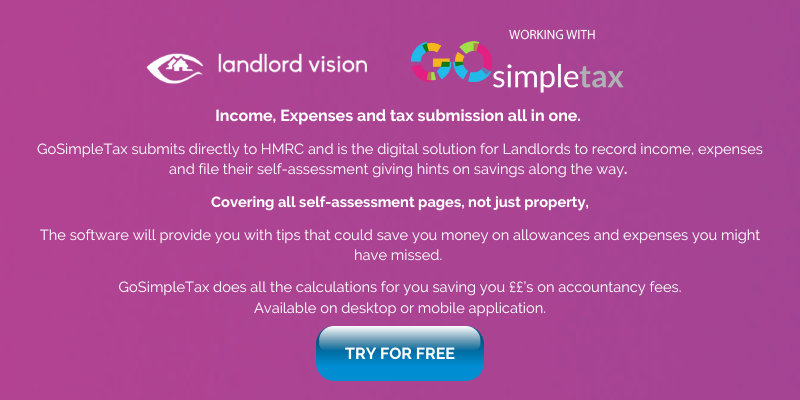
With prices across the board rising faster than they have for decades, many of us are watching the pennies more carefully, tightening our belts, and looking for ways to cut costs.
That includes the UK’s 2.6m private landlords, many of whom can’t put up the rent they charge because tenant’s wages aren’t increasing anywhere near in line with inflation. For many UK private landlords, finding ways to reduce costs is the only way to protect their rental incomes.
If you’re one of the UK’s private landlords, don’t rule out anything when seeking to reduce your costs – and that includes tax. It could well be possible to reduce your tax costs, possibly in ways you hadn’t yet considered. So, how might you be able to reduce your tax costs? GoSimpleTax has kindly answered that question for us. Here are 6 ways to reduce your tax costs.
1. Claim All of Your Allowable Expenses
An obvious place to start. Fortunately, many products and services you need to buy to rent out your property can be claimed as “allowable expenses”, which you deduct from your profits to help minimise your yearly tax bills.
Allowable expenses for landlords include:
- General property maintenance and repairs (but not improvements)
- Water rates
- Council tax
- Possibly gas and electricity
- Insurance
- Gardening and cleaning services
- Letting agent/management fees
- Legal fees for lets of a year or less
- Accountancy fees
- Rent (if you’re sub-letting)
- Ground rents and service charges
- Advertising when looking for new tenants
- Stationery
- Property rental-related phone calls
- Mileage
You’re probably already claiming for many allowable expenses, but you may not be claiming for all of them. Visit the government website GOV.uk to find out more about allowable expenses you can claim.
Poor expense management can also mean you’re not claiming for all of your deductible expenses. Be sure to record all of your expenses and retain receipts and invoices, so that you don’t forget to claim any. Many apps and software allow you to use your smartphone to photograph, store and record receipts, which ensures that you never miss any out.
2. Claim for Home Office Expenses
You can claim allowable expenses for operating a small office in your home to take care of business admin relating to renting out your property. Many private landlords do it. Based on how much time you use your home office, you can claim a share of the total costs for your rent or mortgage interest payments, water rates, domestic heating and lighting, broadband, and phone calls. Stationery and office furniture can also be claimed as an allowable expense.
3. Claim for Other Allowances and Reliefs
You can claim the property allowance, which is a tax allowance worth £1,000 a year. If you claim the property allowance, you can’t claim for allowable expenses, but if you have few allowable expenses and the mortgage is paid, the property allowance can be worth claiming. If you own the property with your partner or spouse and split the profits, you can both claim the property allowance.
Landlords can’t claim the costs of replacing furnishings or equipment in a furnished or part-furnished rental property as an allowable expense, but they may qualify for full Replacement Domestic Items relief for replacing sofas, beds, carpets, curtains, fridges, washing machines, sofas, crockery, cutlery, etc, as long as the quality is comparable, not superior. Such replacements should not come out of your own home or pocket.
Visit the government website GOV.uk for more information about Replacement Domestic Items relief.
4. Claim for Void Periods
The extreme disruption caused by the pandemic meant that some landlords were left with empty rental properties for many months. If you were among them and you still had to pay expenses such as electricity, gas, water, and council tax, make sure you claim for these expenses if you haven’t already.
And like many other UK landlords, you may have made significant losses in recent years as a result of the pandemic. These losses can, of course, be carried forward and claimed against subsequent years when you have made a profit. If you own more than one property, expenses for one property can be offset against income from another.
Read HMRC guidance on setting losses against future profits.
5. Transfer Ownership into a Limited Company
You need to carefully crunch the numbers to find out which option is best for you. Transferring ownership of your property into a limited company can be more tax-efficient, but you need to factor in all other costs, such as accountancy fees, which can be higher because more tax admin is required. More importantly, you also need to consider stamp duty and capital gains tax if you sell property to a limited company that you set up.
If the company needs to take out a commercial mortgage, it’s likely to be more expensive too. You also need to consider the tax implications if you later sell the property. If you own one or two rental properties, transferring ownership to a limited company probably isn’t worthwhile. But if you have a portfolio of more rental properties, transferring ownership to a limited company could prove much more tax-efficient.
6. Do Your Own Self Assessment Tax Returns
For a variety of reasons, you may be paying an accountant to do your bookkeeping and/or take care of your annual Self Assessment tax return. This can cost between £200 and £400 a year, plus VAT. Cheaper deals are available, but you get a very basic service, normally with no tax advice.
If things are really tight, you could save that money by maintaining your own accounts and completing your own Self Assessment tax return. If you’ve not done it before, it will involve some research and learning, but it may be possible to complete your Self Assessment tax return in less time than you think. Reportedly, it takes just 2.5 hours on average.
Self Assessment tax return software/apps can make the task much easier, while you’re less likely to make mistakes. They are available for upwards of about £50 a year, which offers a great saving when compared to paying an accountant’s fees. You’ll need to input your own figures, but this can be simple enough if you’re already using bookkeeping software.




